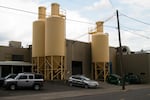Related: Oregon's New Air Pollution Rules Are Already Being Debated
Oregon polluters will now be subject to limits on the total health risk they can impose on the people who live and work near their facilities.
The Oregon Environmental Quality Commission unanimously approved rules Thursday that seek to close an "air toxics gap" under current regulations. Regulators say that gap contributed to heavy metals pollution by a Portland art glass company in 2016.
Officials said the new rules mark a shift in Oregon environmental standards — one that that considers the public health impact of Oregon's top polluters.
“Today’s vote marks the most significant step towards ensuring Oregonians' right to clean air in 30 years,” said Gov. Kate Brown in a press release Thursday. “We reached this milestone by working together in partnership and with an unwavering commitment to protecting the health of Oregonians.”
Discoveries at the Portland glass-making facilities prompted Brown to launch the Cleaner Air Oregon program in 2016. The problem, regulators had discovered at the time, was that Oregon's existing air pollution regulations were only based on federal rules that failed to consider risks to the health of locals living near pollution centers.
"We didn't know about the emissions, and [in] finding out about them, we didn't have any regulatory tools to address them," said Keith Johnson, program manager for Cleaner Air Oregon. "And that's where this gap in our air toxics regulations came to fruition. That concern went across a lot of different facilities across Portland, it wasn't just that one."
Mary Peveto, president of Neighbors for Clean Air, said the new rules mark a paradigm shift in how air quality permits are doled out to companies. For example, Peveto said, regulators previously only had oversight of which technologies companies had to have in place, without consideration for whether the technologies actually created clean air to breathe.
"That is a really important shift from when they couldn't really consider health and the risk of health when they were issuing new permits," Peveto said.

Bullseye Glass in Southeast Portland.
Bryan M. Vance / OPB
The new rules passed this week lay the groundwork for the Cleaner Air Oregon program, which will require companies to report their use of 600 different chemicals and the health risks they pose. The rules require polluters to reduce emissions if they exceed total health risk limits.
DEQ has funding from the state Legislature for 11 new positions to implement the program.
The rules will target the most egregious polluters and bring them into compliance over the next five years.
"I think the really important part of the program is that we'll have an understanding of what is being emitted by industrial facilities," said Dave Farrer, a state toxicologist with the Oregon Health Authority.
He says the program gives Oregonians a clearer sense of potential health risks.
"It’s information that communities living around facilities have never had in Oregon, and now over time, that will become normal," Farrer said.
Peveto, who was critical of standards being set early on in the rule-making process, said that while it was clear community groups were not going to make wins on hard standards they advocated for in the program, the upside is a new level of transparency around risks.
"I think this will give Oregonians an unprecedented amount of information about the risks that these manufacturing facilities, these permitted sites, potentially create when they release toxic air pollution," Peveto said.